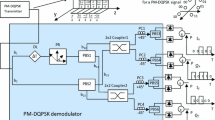Abstract
In this paper, we investigate the impact of the transmitter finite extinction ratio and the receiver carrier recovery phase offset on the error performance of two optically preamplified hybrid M-ary pulse position modulation (PPM) systems with coherent detection. The first system, referred to as PB-mPPM, combines polarization division multiplexing (PDM) with binary phase-shift keying and M-ary PPM, and the other system, referred to as PQ-mPPM, combines PDM with quadrature phase-shift keying and M-ary PPM. We provide new expressions for the probability of bit error for PB-mPPM and PQ-mPPM under finite extinction ratios and phase offset. The extinction ratio study indicates that the coherent systems PB-mPPM and PQ-mPPM outperform the direct-detection ones. It also shows that at \(P_b=10^{-9}\) PB-mPPM has a slight advantage over PQ-mPPM. For example, for a symbol size \(M=16\) and extinction ratio \(r=30\) dB, PB-mPPM requires 0.6 dB less SNR per bit than PQ-mPPM to achieve \(P_b=10^{-9}\). This investigation demonstrates that PB-mPPM is less complex and less sensitive to the variations of the offset angle \(\theta \) than PQ-mPPM. For instance, for \(M=16\), \(r=30\) dB, and \(\theta =10^{\circ }\) PB-mPPM requires 1.6 dB less than PQ-mPPM to achieve \(P_b=10^{-9}\). However, PB-mPPM enhanced robustness to phase offset comes at the expense of a reduced bandwidth efficiency when compared to PQ-mPPM. For example, for \(M=2\) its bandwidth efficiency is 60 % that of PQ-mPPM and \(\approx 86\,\%\) for \(M=1024\). For these reasons, PB-mPPM can be considered a reasonable design trade-off for M-ary PPM systems.









Similar content being viewed by others
References
Phillips, A., Cryan, R., Senior, J.: Performance evaluation of optically preamplified PPM systems. Photon. Technol. Lett. IEEE 6(5), 651–653 (1994)
Phillips, A., Cryan, R., Senior, J.: Optically preamplified pulse-position modulation for fibre-optic communication systems. Optoelectron. IEE Proc. 143(2), 153–159 (1996)
Kiasaleh, K.: Performance of APD-based, PPM free-space optical communication systems in atmospheric turbulence. IEEE Trans. Commun. 53(9), 1455–1461 (2005)
Caplan, D., Robinson, B., Murphy, R., Stevens, M.: Demonstration of 2.5 Gslots/s optically-preamplified M-PPM with 4 photons/bit receiver sensitivity. In: Proceedings of the 2005 OFC/NFOEC, pp. 1–3. (2005)
Caplan, D.: Laser communication transmitter and receiver design. J. Opt. Fiber Commun. Rep. 4(5), 225–362 (2007)
Edwards, B.L., Israel, D., Wilson, K., Moores, J.D., Fletcher, A.S.: The laser communications relay demonstration. In: The 2012 International Conference on Space Optical Systems and Applications (ICSOS), pp. 1–9. (2012)
Chandrasekhar, S., Liu, X., Wood, T.H., Tkach, R.W.: High sensitivity modulation formats. In: Proceedings of the 2012 OFC/NFOEC, pp. 1–3. (2012)
Landolsi, T., Elrefaie, A.: Error performance of preamplified optical PPM systems with finite extinction ratios. J. Opt. Fiber Technol. 20, 365–368 (2014)
Landolsi, T., Elrefaie, A.: Performance evaluation of optically preamplified PPM systems with dual-polarized ASE noise and finite extinction ratios. IEEE Trans. Commun. 62(10), 3644–3651 (2014)
Seimetz, M., Weinert, C.M.: Options, feasibility, and availability of \(2\times 4\) \(90^{\circ }\) hybrids for coherent optical systems. IEEE J. Lightwave Technol. 24(3), 1317–1322 (2006)
Liu, X., Wood, T., Tkach, R., Chandrasekhar, S.: Demonstration of record sensitivities in optically preamplified receivers by combining PDM-QPSK and M-ary pulse-position modulation. J. Lightwave Technol. 30(4), 406–413 (2012)
Landolsi, T., Hassan, M.S., Elrefaie, A.F., Hamid, S.: Performance evaluation of optically-preamplified hybrid QPSK M-ary PPM systems with finite extinction ratios. J. Opt. Fiber Technol. 25, 33–38 (2015)
Yu, M., et al.: Nyquist-mPPM-QPSK modulation for power and spectrum efficient optical communications. In: 2016 Optical Fiber Communications Conference (OFC), pp. 1–3. (2016)
Pauer, M., Winzer, P.: Impact of extinction ratio on return-to-zero coding gain in optical noise limited receivers. Photon. Technol. Lett. IEEE 15(6), 879–881 (2003)
Wei, H., Elrefaie, A.F., Xue, X., Wang, S.Y.: Generation of Optical Signals with Return-to-Zero Format. US Patent 2002/0196508 A1 (2002)
Hamid, S., Hassan, M., Elrefaie, A.: Performance of optically-preamplified PDM-BPSK M-ary PPM and PDM-QPSK-M-ary PPM systems with finite extinction ratio. In: 2015 IEEE 8th GCC Conference and Exhibition (GCCCE), pp. 1–6. (2015)
Kazovsky, L.G.: Balanced phase-locked loops for optical homodyne receivers: performance analysis, design considerations, and laser linewidth requirements. IEEE J. Lightwave Technol. 4(2), 182–195 (1986)
Norimatsu, S., Iwashita, K.: Linewidth requirements for optical synchronous detection systems with nonnegligible loop delay time. IEEE J. Lightwave Technol. 10(3), 341–349 (1992)
Geisler, D.J., et al.: Demonstration of 2.1 photon-per-bit sensitivity for BPSK at 9.94-Gb/s with rate-1/2 FEC. In: Proceedings of the 2013 OFC/NFOEC, pp. 1–3. (2013)
Zhang, S., Kam, P., Yu, C., Chen, J.: Decision-aided carrier phase estimation for coherent optical communications. IEEE J. Lightwave Technol. 28(11), 1597–1607 (2010)
Prabhu, V.K.: PSK performance with imperfect carrier phase recovery. IEEE Trans. Aerosp. Electron. Syst. AES–12(2), 275–286 (1976)
Hamid, S.: Performance Evaluation of Optically Preamplified M-ary PPM Systems for Free-Space Optical Communications. Master’s thesis, American University of Sharjah (2012)
Olsson, N.A.: Lightwave systems with optical amplifiers. IEEE J. Lightwave Technol. 7(7), 1071–1082 (1989)
Ramaswami, R., Sivarajan, K., Sasaki, G.: Optical Networks: A Practical Perspective, chap. 4, 3rd edn. Morgan Kaufmann (2009)
Ho, K.P.: Phase-Modulated Optical Communication Systems, 1st edn. Springer, New York (2005)
Jeruchim, M.C., Balaban, P., Shanmugan, K.S.: Simulation of Communication Systems: Modeling, Methodology and Techniques, chap. 5, 2nd edn. Springer (2000)
Tychopoulos, A., Koufopavlou, O., Tomkos, I.: FEC in optical communications–a tutorial overview on the evolution of architectures and the future prospects of outband and inband FEC for optical communications. IEEE Circuits Devices Mag. 22(6), 79–86 (2006)
Author information
Authors and Affiliations
Corresponding author
Rights and permissions
About this article
Cite this article
Landolsi, T., Elrefaie, A.F., Hamid, S. et al. Error performance of optically preamplified hybrid BPSK-PPM systems with transmitter and receiver imperfections. Photon Netw Commun 33, 231–242 (2017). https://doi.org/10.1007/s11107-016-0636-1
Received:
Accepted:
Published:
Issue Date:
DOI: https://doi.org/10.1007/s11107-016-0636-1




